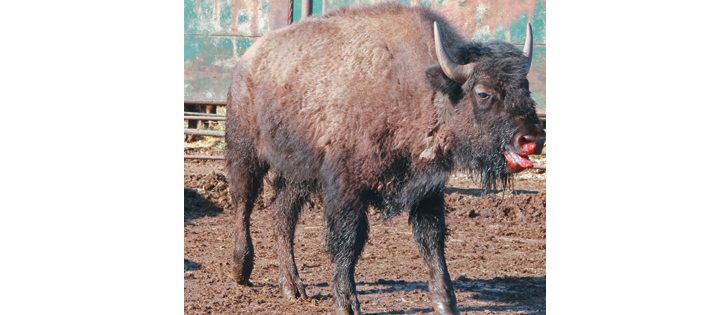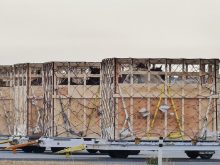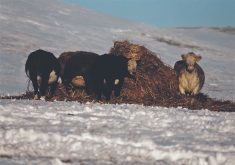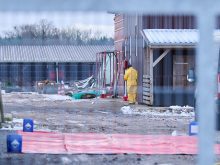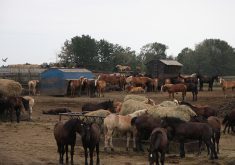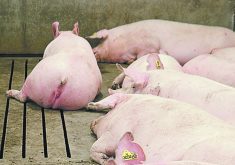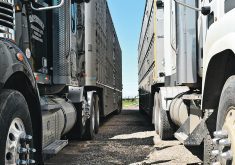PONOKA, Alta. — The new manager of the Tsuu T’ina Nation’s bison herd is apologizing for the highly stressed, stunted and parasite-infested animals that were recently brought to a commercial bison sale.
James McGuiness said he was embarrassed by the 130 bison brought to the Vold Jones Vold Auction bison sale March 15, which followed the Alberta Bison Producers Wildrose show and sale.
Several of the bison were obviously stressed from the truck ride from the First Nation reserve outside Calgary to Ponoka. The animals were bashing themselves against the corrals or trying to leap over the heavy pipe fences as they attempted to escape. Several bison producers watching the frantic animals didn’t think they would live.
Read Also

Farming Smarter receives financial boost from Alberta government for potato research
Farming Smarter near Lethbridge got a boost to its research equipment, thanks to the Alberta government’s increase in funding for research associations.
“They’re so wild. That’s the way the old manager raised them. He was old school,” said McGuiness, who was appointed bison manager of the Tsuu T’ina Nation herd a week earlier and said he knows little about bison.
McGuiness said the previous bison manager was elderly and believed in little contact with the bison. Instead of getting the animals accustomed to human interaction, he placed bales in the field and left them on their own.
Bison producer Ivan Smith said the poor condition of the animals that arrived at the auction speaks of neglect and poor management.
“The animals that were brought in were in really poor health. It’s really sad to see. They’re not hard animals to look after, but they need the basics,” said Smith, who stayed up all night helping auction staff put Canadian Cattle Identification Agency tags on the bison after they arrived at the auction just before midnight.
“It’s sad. It’s neglect,” said Smith. “It looks poorly on the whole industry.”
He said with bison fetching record high prices, there is no excuse for animals riddled with parasites or stunted from lack of feed.
Smith said it wasn’t uncommon to see bison herds in poor shape in 2003 after BSE stopped the export of bison and prices plummeted. However, the increasing demand for bison and strong prices means that it pays to keep bison in good health.
This kind of herd is rare, he added.
McGuiness said the old manager put round bales in the field and let the animals fend for themselves. The older, stronger animals got the best feed and the smaller yearlings were outmuscled.
He said he has bought a bale processor since taking over to spread the bale into long lines so that all the animals are able to feed and get used to human contact.
“We’re trying to change now so this doesn’t happen anymore.”
McGuiness said he plans to get rid of the wildest animals, buy good bulls and improve the herd.
Several animals were too wild to be loaded onto the trucks, he added.
“I want to try to remake the herd into a workable herd so they don’t come in like this,” said McGuiness, who bought two of the winning bulls from the Wildrose Show and Sale just before the commercial bison were sold.
Veterinarian Roy Lewis said letting all ages of bison run together doesn’t work. Bison need to be separated by age as a minimum requirement.
Cows running together as a group will protect their calves, but the yearlings and two year olds are on their own in a group setting and don’t fare well.
“The yearlings in the middle always get beat up.”
Smith said the cows and calves in the herd were in decent shape, but the yearlings and two year olds were severely stunted.
Smith bought 211 bison at the commercial sale. More than half of them were from the Tsuu T’ina Nation herd.
Some of the calves sold for 10 cents a pound instead of the market price of $2 a lb. Smith said the rest of the herd fetched higher prices than they deserved because of the strong demand for bison meat.
“The demand is strong and people took a gamble on them because the demand is needed,” said Smith.
James Goransrud of Camrose, a member of the Wildrose Show and Sale committee, said it’s important for inexperienced bison producers to ask for help in raising bison.
“It’s not just a matter of having land and putting bison on it,” he said.
“These animals are wild animals and if they have not had proper handling, damage can occur.”
He said McGuiness should join the provincial bison producers association and start coming to meetings to learn about raising bison.
“It’s important to mentor people getting into the business. They need mentors in a big way. You need some one to go in at the start and develop proper handling system and get some training,” he said.
“It’s very difficult for this young guy stepping in. It is so important to join the association and get some help. I encouraged him to get a membership.”
McGuiness said he hopes to replace the reserve’s old wooden corrals with a modern handling facility, which is one more step in getting the bison used to people and coming to auctions.
“They are not used to corrals. When 200 to 300 buffalo are that wild and come in, the board fences aren’t strong enough,” he said.
Lewis believes live auction bison sales may be a thing of the past.
The cost of bringing the animals to market, stress and potential for disease transmission may end future bison sales, including the association’s premier Wildrose Show and Sale.
“I wouldn’t be surprised if this sale didn’t end up in video sale in two years.”
Smith said video auctions aren’t ideal, but they may be a good replacement for live animal auctions, which cause a lot of stress on the bison. He said bloody noses and tongues aren’t uncommon at sales, where the animals bash into fences frantic to escape.
“I have never been to a bison sale where there haven’t been bison deaths,” said Smith.
Lorna Baird, executive director of the Alberta Farm Animal Care network, said the organization has not had a single bison-related call to its Alert Line in two years.
The Alberta SPCA said it received 54 calls about bison between 2009 – 2013, and 12 were “founded welfare concerns.”



